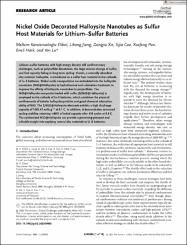Nickel oxide decorated halloysite nanotubes as sulfur Host materials for lithium–sulfur batteries

View/
Access
info:eu-repo/semantics/openAccessDate
2023Author
Elibol, Meltem KaraismailoğluJiang, Lihong
Xie, Dongjiu
Cao, Sijia
Pan, Xuefeng
Härk, Eneli
Lu, Yan
Metadata
Show full item recordCitation
Elibol, Meltem K., Jiang, L., Xie, D., Cao, S., Pan, X., Härk, E., Lu, Y. (2023). Nickel oxide decorated halloysite nanotubes as sulfur Host materials for lithium–sulfur batteries.Abstract
Lithium–sulfur batteries with high energy density still confront manychallenges, such as polysulfide dissolution, the large volume change of sulfur,and fast capacity fading in long-term cycling. Herein, a naturally abundantclay material, halloysite, is introduced as a sulfur host material in the cathodeof Li–S batteries. Nickel oxide nanoparticles are embedded into the halloysitenanotubes (NiO@Halloysite) by hydrothermal and calcination treatment toimprove the affinity of halloysite nanotubes to polysulfides. TheNiO@Halloysite composite loaded with sulfur (S/NiO@Halloysite) isemployed as the cathode of Li–S batteries, which combines the physicalconfinements of tubular halloysite particles and good chemical adsorptionability of NiO. The S/NiO@Halloysite electrode exhibits a high dischargecapacity of 1205.47 mAh g−1at 0.1 C. In addition, it demonstrates enhancedcycling stability, retaining≈60% of initial capacity after 450 cycles at 0.5 C.The synthesized NiO@Halloysite can provide a promising prospect andvaluable insight into applying natural clay materials in Li–S batteries
Source
Global ChallengesVolume
7Issue
7URI
https://onlinelibrary.wiley.com/doi/epdf/10.1002/gch2.202300005https://hdl.handle.net/20.500.12846/864
















